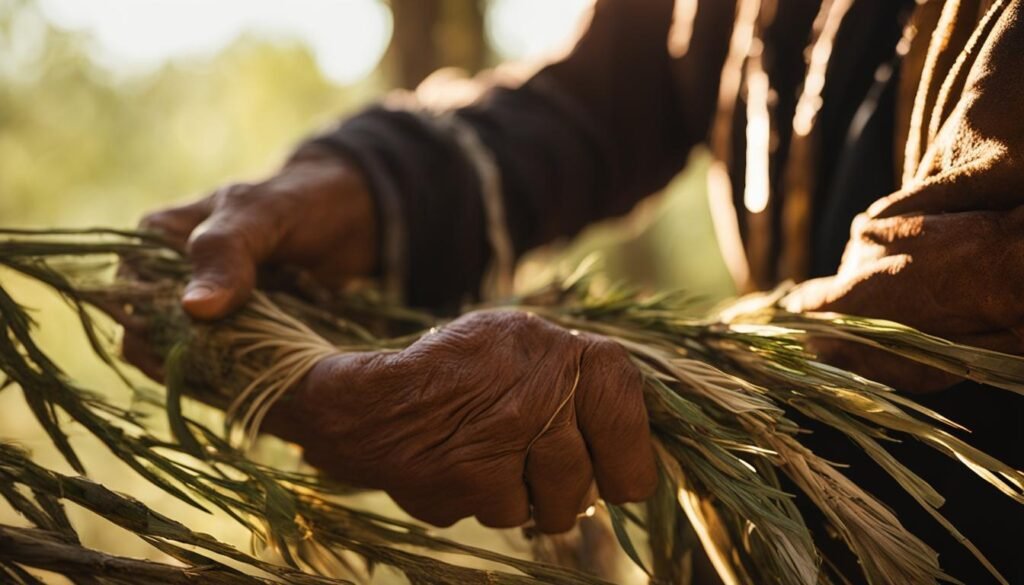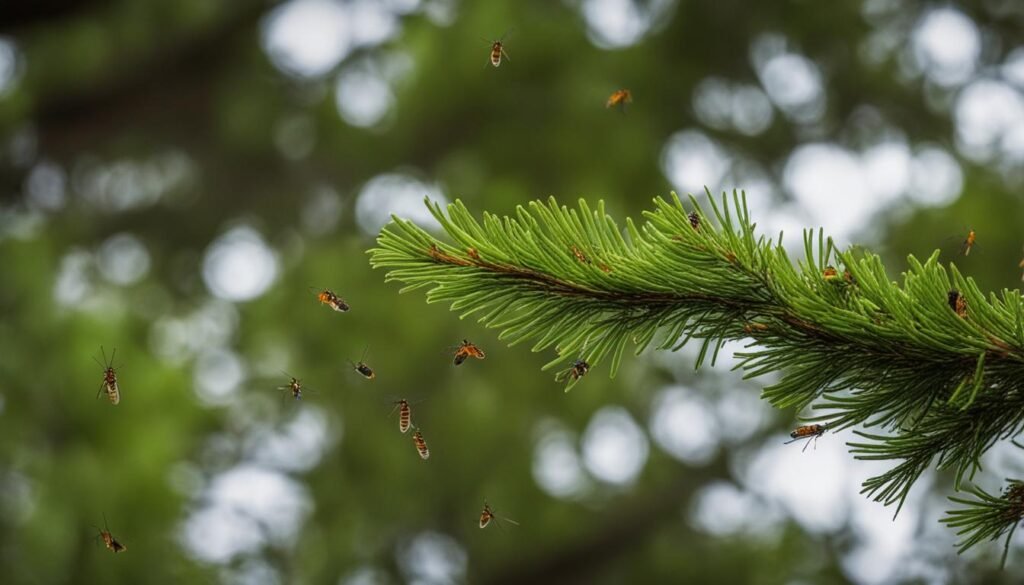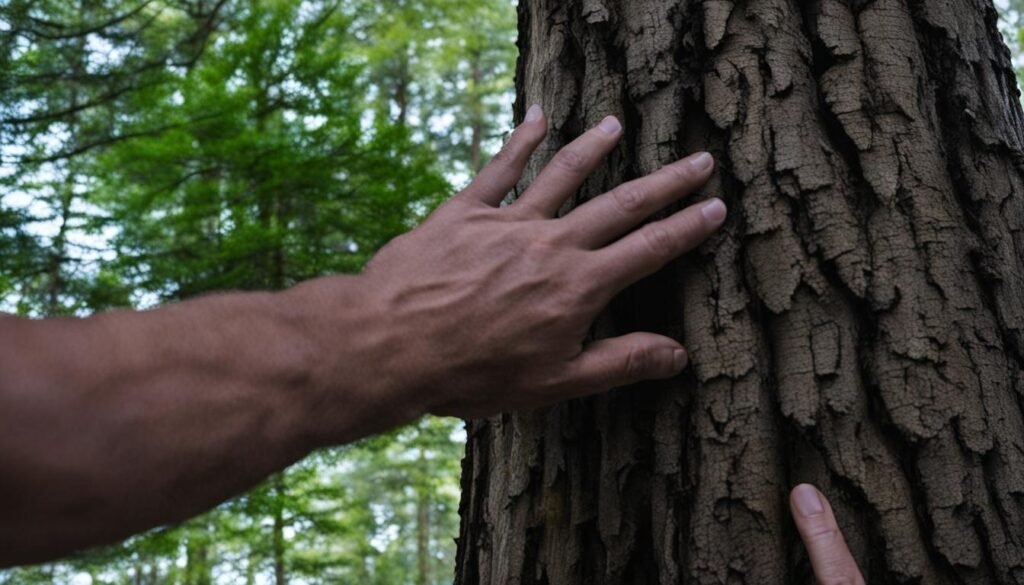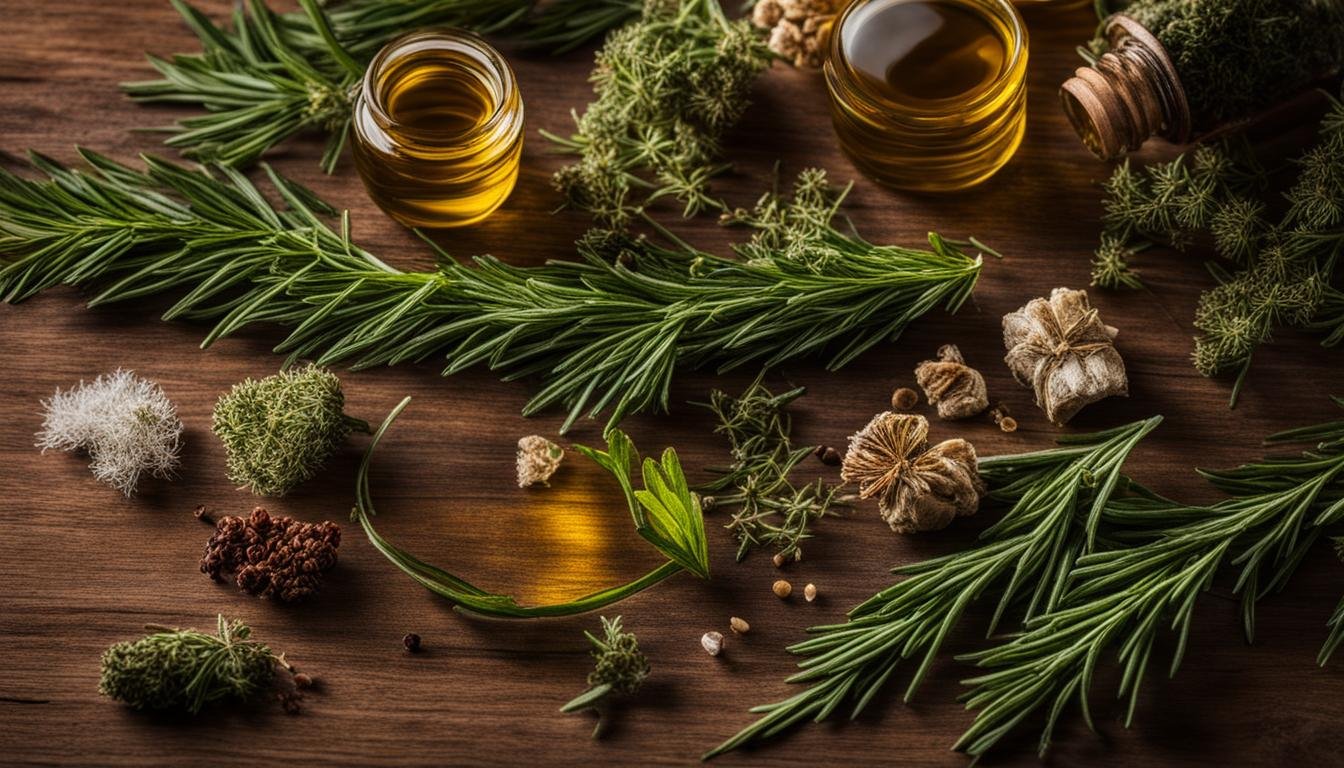As a journalist, I am fascinated by the rich history and cultural significance of cedar trees. These majestic trees have played a vital role in Indigenous communities throughout North America for thousands of years. Not only are they admired for their beauty and resilience, but they also offer a wide range of medicinal uses and therapeutic benefits.
Cedar trees have long been recognized for their healing properties, making them a staple in traditional medicine. Native Americans relied on cedar for treating various respiratory illnesses, such as colds and coughs. They brewed cedar tea made from the leaves and bark, harnessing its power to reduce fevers, relieve pain, aid digestion, and even repel insects. Today, cedarwood essential oil is widely used in aromatherapy and personal care products for its relaxation and stress-reducing properties.
Key Takeaways:
- Cedar trees have been valued for their medicinal properties by Indigenous communities for centuries.
- Native Americans used cedar for respiratory ailments, pain relief, and as a natural insect repellent.
- Cedarwood essential oil is commonly used in aromatherapy and personal care products.
- Cedar has practical applications in building, including canoes and structures.
- It is important to use cedar responsibly and respect its cultural significance.
Traditional Uses of Cedar in Native American Communities
Cedar has been an integral part of Native American communities for centuries, with various traditional uses that extend beyond medicinal purposes. The bark of the cedar tree was utilized for making clothing and baskets, showcasing the resourcefulness and craftsmanship of Indigenous people. Additionally, the wood was highly valued for constructing canoes, longhouses, and other important structures. These practical applications highlight the versatility and durability of cedar in meeting the everyday needs of Native American communities.
In addition to its practical uses, cedar held significant medicinal value in Native American cultures. The leaves and bark of the cedar tree were used for treating a range of ailments, including rheumatism, coughs, and fevers. Native Americans would create remedies from the leaves and bark, harnessing the therapeutic properties of cedar for healing purposes. Furthermore, the smoke derived from burning cedar was used in purification ceremonies, emphasizing the spiritual significance of cedar in Native American traditions. These traditional uses reflect the deep connection and reverence that Native American communities had for cedar.
The cultural importance of cedar in Native American communities cannot be overstated. Beyond its practical and medicinal uses, cedar played a vital role in ceremonial and spiritual practices. The distinct aroma of cedar smoke was believed to cleanse and purify both individuals and spaces, making it a crucial element in various rituals. The symbolism and protective qualities associated with cedar made it a sacred plant, representing longevity, incorruptibility, and spiritual protection. Cedar’s cultural significance continues to be honored and respected by Indigenous communities to this day.

Table: Traditional Uses of Cedar in Native American Communities
| Traditional Uses | Description |
|---|---|
| Clothing and Baskets | The bark of the cedar tree was used to make clothing and baskets. |
| Canoe and Structure Construction | The wood of the cedar tree was used for building canoes, longhouses, and other structures. |
| Medicinal Remedies | The leaves and bark of the cedar tree were utilized for treating ailments such as rheumatism, coughs, and fevers. |
| Purification Ceremonies | The smoke from burning cedar was used in purification ceremonies, cleansing individuals and spaces. |
Practical Applications of Cedar Trees
When it comes to practical uses, cedar trees have been highly valued by Native Americans for their versatility and durability. From building materials to woven items, cedar has found its place in various aspects of daily life.
Table: Practical Applications of Cedar Trees
| Application | Description |
|---|---|
| Cedar Bark Clothing | Cedar bark was skillfully woven into clothing by Native Americans, providing protection and insulation. |
| Cedar Wood Structures | The lightweight and durable cedar wood was used to construct canoes, longhouses, and other structures. |
| Cedar Baskets | Native Americans crafted baskets from cedar bark, using them for storage and transportation of goods. |
| Outdoor Furniture | Cedar’s resistance to weather and decay makes it a popular choice for outdoor furniture. |
| Decking and Siding | Cedar’s natural beauty and durability make it an excellent option for decking and siding. |
| Greenhouses | Cedar’s natural insect-repellent properties make it a suitable material for constructing greenhouses. |
As seen in the table above, cedar trees provided essential materials for clothing, structures, and even baskets used in daily life. The lightweight and durable nature of cedar wood made it ideal for constructing canoes, longhouses, and other structures. Additionally, cedar’s resistance to weather and decay has led to its continued use in outdoor furniture, decking, and siding.
One notable application of cedar is its use in constructing greenhouses. Cedar’s natural insect-repellent properties make it an excellent choice for protecting plants from pests, creating an environment conducive to healthy growth.
Overall, the practical uses of cedar trees highlight their importance and value in Native American communities and beyond. From clothing and structures to outdoor furniture and greenhouses, cedar continues to be a versatile and reliable resource.
The Therapeutic Properties of Cedar Trees
Cedar trees possess a wide range of therapeutic properties that have been recognized for centuries. These properties make cedar trees valuable in various applications such as aromatherapy, personal care products, and natural remedies. The healing properties of cedar trees can have a holistic impact on our well-being.
One of the most well-known therapeutic benefits of cedar trees is the relaxation and stress-reducing properties of cedarwood essential oil. The warm and woodsy aroma of cedarwood oil is often used in aromatherapy to promote relaxation, reduce stress and anxiety, and improve sleep quality. In addition to its calming effects, cedarwood essential oil also has antifungal and antibacterial properties, making it a popular ingredient in personal care products.
Furthermore, the wood and leaves of cedar trees have their own therapeutic properties. Cedar wood and leaves contain antimicrobial and antiviral properties, which can help combat various pathogens. These properties make cedar trees valuable in natural remedies for respiratory illnesses, skin infections, and nail fungus. In addition, cedar leaves have been used in traditional medicine for their antifungal properties and as a treatment for rheumatism and fevers.
The holistic benefits of cedar trees extend beyond their therapeutic properties. Cedar trees have a unique ability to create a sense of peace, balance, and spiritual connection. The sacred and protective symbolism associated with cedar adds to its cultural significance. Incorporating cedar into our lives can not only benefit our physical and mental well-being but also help us honor the deep connection between cedar trees and Indigenous communities.

The Healing Power of Cedar Trees
Cedar trees have been revered for their healing properties for centuries. The therapeutic benefits of cedarwood essential oil, along with the antimicrobial and antiviral properties of cedar leaves and wood, make cedar trees a valuable resource in natural medicine. By harnessing the holistic benefits of cedar trees, we can enhance our well-being and connect with the rich cultural heritage associated with these majestic trees.
Cedar in Modern Applications
As the popularity of natural remedies and wellness practices continues to rise, cedar is finding a place in modern applications. One of the most common uses of cedar is in the form of cedarwood essential oil, which is widely used in aromatherapy and personal care products. The warm and woodsy aroma of cedarwood essential oil is known to promote relaxation and reduce stress and anxiety. It is also valued for its antifungal and antibacterial properties, making it a popular ingredient in skincare products.
When it comes to outdoor and indoor furniture, cedar is a top choice for both its natural beauty and durability. Its resistance to weather and decay makes it an excellent option for decking, siding, and even greenhouses. Cedar’s natural oils act as a deterrent to pests, making it an ideal material for protecting plants and repelling insects. In fact, cedar is still used today for pest control, with products such as cedar hangers and sachets being used to ward off moths and other pests.
Table:
| Cedar in Modern Applications | Benefits |
|---|---|
| Aromatherapy | Relaxation, stress reduction |
| Skincare | Antifungal, antibacterial |
| Outdoor/indoor furniture | Durable, weather-resistant |
| Pest control | Natural insect repellent |
Whether it’s in the form of essential oil, furniture, or pest control, cedar continues to be valued for its practical and therapeutic properties. Its versatility and natural benefits make it a sought-after choice in various modern applications.
Cedar as a Natural Insect Repellent
Cedar has long been recognized for its natural insect-repellent properties, making it an effective solution for pest control. Native Americans have been using cedar for centuries to repel mosquitoes and other pests. Today, cedar continues to be a popular choice for keeping unwanted insects away in various forms.
One common use of cedar as an insect repellent is through the use of cedar hangers and sachets. These products are often placed in closets or drawers to protect clothing and linens from moths, silverfish, and other pests. The aromatic properties of cedar act as a natural deterrent, keeping insects at bay without the need for harsh chemicals or pesticides.
I love using cedar hangers in my closet. Not only do they keep moths away, but they also leave a subtle and pleasant scent on my clothes. It’s a natural and effective way to protect my garments while enjoying the benefits of cedar.
In addition to its use in clothing storage, cedar is also utilized in the construction of greenhouses. The wood of cedar contains natural oils and compounds that repel common greenhouse pests, such as aphids and mites. By incorporating cedar into the structure of a greenhouse, gardeners can create an environment that is inhospitable to pests, leading to healthier plants and increased crop yields.
Overall, cedar’s insect-repellent properties make it a versatile and eco-friendly option for pest control. Whether it’s in the form of hangers, sachets, or as a construction material, cedar provides a natural and effective solution to keep insects away.

Cedar in Smoke Cleansing
Smoke cleansing, also known as smudging, is a practice that has been used by various cultures for centuries to cleanse and purify a space or a person. One of the most commonly used materials in smoke cleansing rituals is cedar. Burning cedar produces a fragrant smoke that is believed to have spiritual and healing properties, promoting positive energies and clearing away negativity.
In Native American traditions, cedar smoke is used in purification ceremonies to cleanse the energy of a space or an individual. The smoke is often fanned with feathers or spread using a smudging tool such as a turkey feather or a shell. As the smoke wafts through the air, it is believed to carry away unwanted energies, leaving behind a purified and harmonious environment.
“The scent of cedar smoke is deeply grounding and calming. It helps me create a sense of sacred space and connects me to the natural world,” says Sarah, a practitioner of smudging with cedar.
Cedar smoke cleansing is not only limited to spiritual or ceremonial practices. Many individuals use cedar smudging as part of their daily routine to promote a sense of peace and well-being. The therapeutic aroma of cedar smoke is known to have a relaxing effect on the mind and body, helping to reduce stress and anxiety. It creates a serene atmosphere that encourages inner balance and harmony.
Benefits of Cedar Smoke Cleansing
There are several benefits associated with the practice of cedar smoke cleansing:
- Spiritual purification: Cedar smoke is believed to cleanse and purify negative energies, creating a sacred space for spiritual practices and rituals.
- Relaxation and stress relief: The aroma of cedar smoke has calming properties, helping to alleviate stress and anxiety.
- Clearing negative energy: Cedar smoke is thought to dispel negative energy and promote positive vibrations in a space or an individual.
- Connecting with nature: The scent of cedar smoke creates a connection to the natural world, fostering a sense of grounding and harmony.
Whether used in traditional Native American ceremonies or modern spiritual practices, cedar smoke cleansing with its unique aroma and spiritual significance provides a powerful tool for creating a sense of peace, balance, and spiritual connection.
Medicinal Uses of Cedar Leaves
Cedar leaves have been valued for their medicinal properties by Native Americans and other cultures for centuries. The leaves of the cedar tree are commonly used to make cedar leaf tea, which has been traditionally used to treat various ailments. Cedar leaf tea has been used to alleviate symptoms of rheumatism, coughs, tuberculosis, and fevers. It has also been used for incense and smudging purposes, offering a natural and aromatic way to cleanse and purify the air.

Cedar leaves are known for their antifungal properties, making them an effective natural remedy for skin and nail infections caused by fungi. The leaves can be used topically as an oil, salve, or tincture to treat fungal infections. Additionally, soaking feet in cedar leaf tea has been found to be beneficial in treating fungal infections of the feet, such as athlete’s foot.
Medicinal Benefits of Cedar Leaves:
- Rheumatism: Cedar leaf tea has been used to relieve symptoms of rheumatism, including joint pain and inflammation.
- Coughs and Tuberculosis: Cedar leaf tea has been used as an expectorant to help alleviate coughs and symptoms of tuberculosis.
- Fevers: Cedar leaf tea has been traditionally used to reduce fevers and promote overall wellness.
- Antifungal Properties: Cedar leaves have natural antifungal properties and can be used to treat skin and nail infections caused by fungi.
It is important to note that while cedar leaves have medicinal benefits, it is always advisable to consult a healthcare professional before using cedar leaf remedies, especially if you have any underlying health conditions or are taking medications. It is also essential to ensure you are properly identifying and using cedar leaves, as there are different species of cedar trees with varying medicinal properties.
Cedar as an Immune Booster
Cedar trees offer impressive immune-boosting properties that can support overall health and well-being. As a natural remedy, cedar stimulates the production of white blood cells, such as macrophages, which play a vital role in fighting off infections and promoting a healthy immune response. Incorporating cedar into your wellness routine can help fortify your body’s natural defenses and enhance your resistance to illness.
One way to harness the immune-boosting benefits of cedar is through respiratory health. Steam inhalation with cedar essential oil or drinking cedar tea can provide relief from congestion and respiratory infections. The inhalation of cedar-infused steam helps to clear the airways, soothe irritation, and promote easier breathing. Additionally, cedar tea can help reduce inflammation in the respiratory system, easing symptoms associated with colds, coughs, and allergies.
When considering the use of cedar as an immune booster, it is important to consult a healthcare professional. They can provide guidance on the appropriate dosage and usage for your specific needs and health conditions. While cedar offers numerous benefits, it is crucial to use it responsibly and in moderation to avoid any potential adverse effects.
The Immune-Boosting Benefits of Cedar:
| Benefits | How to Use |
|---|---|
| Stimulates white blood cell production | – Steam inhalation with cedar essential oil – Drinking cedar tea |
| Relieves congestion and respiratory infections | – Steam inhalation with cedar essential oil – Drinking cedar tea |
| Reduces inflammation in the respiratory system | – Drinking cedar tea |
By incorporating cedar into your wellness routine, you can tap into its immune-boosting potential and support your body’s natural defense mechanisms. However, it is always wise to consult with a healthcare professional to ensure its safe and appropriate use for your individual needs.

Caution and Considerations When Using Cedar
When using cedar for its medicinal properties, it is important to exercise caution and consider certain factors. Cedar contains strong volatile oils, including the ketone thujone, which can be toxic in large quantities. Therefore, it is crucial to use cedar in appropriate dosages and avoid prolonged use.
Additionally, there are certain groups of people who should avoid using cedar for medicinal purposes. Pregnant and breastfeeding women should refrain from using cedar, as well as individuals with kidney weakness. It is always advisable to consult with a healthcare professional before incorporating cedar into your healthcare routine.
While cedar is generally safe to use, it is possible for some individuals to experience allergic reactions. If you have a known sensitivity or allergy to cedar, it is best to avoid using cedar products.
By following these precautions and considering your own individual health needs, you can safely enjoy the many benefits that cedar has to offer.
Table: Precautions and Considerations When Using Cedar
| Precautions | Considerations |
|---|---|
| Avoid using cedar in large quantities | Consult a healthcare professional before use |
| Cedar should not be used during pregnancy, breastfeeding, or if you have kidney weakness | Individuals with known cedar allergies should avoid use |

“Cedar contains strong volatile oils that can be toxic in large quantities, especially the ketone thujone.”
The Importance of Sustainability in Cedar Usage
Cedar trees have been valued for their numerous uses and benefits for centuries, but as the demand for cedar products continues to rise, it becomes crucial to prioritize sustainability and responsible harvesting practices. Sustainable cedar usage ensures the preservation of these valuable ecological resources and respects the cultural significance they hold for Indigenous communities.
Responsible cedar harvesting involves practices such as selective cutting, which allows for the regeneration of cedar forests and maintains the overall health of the ecosystem. Additionally, replanting initiatives play a vital role in sustaining the cedar population for future generations. By replanting cedar trees, we contribute to the restoration of habitats and the preservation of biodiversity.
Respecting Indigenous protocols for gathering cedar is another essential aspect of sustainable cedar usage. Indigenous communities have cultivated deep knowledge and understanding of cedar trees over generations. By honoring their protocols and involving Indigenous communities in the management of cedar resources, we can ensure the cultural continuity and well-being of these communities.
| Sustainability Practices | Benefits |
|---|---|
| Selective harvesting | Allows for forest regeneration and ecological balance |
| Replanting initiatives | Preserves cedar populations and supports biodiversity |
| Respecting Indigenous protocols | Promotes cultural preservation and community empowerment |
Supporting companies that prioritize sustainable sourcing of cedar products is also of utmost importance. By choosing products from companies that follow ethical and sustainable practices, we contribute to the demand for responsibly sourced cedar and send a message to the industry that sustainability matters.
In conclusion, sustainability should be at the forefront when it comes to cedar usage. By implementing responsible harvesting practices, respecting Indigenous protocols, and supporting sustainable companies, we can ensure the long-term conservation of cedar trees, protect ecosystems, and honor the cultural significance of this remarkable resource.

| Cultural Importance of Cedar | Cedar in Indigenous Traditions |
|---|---|
| Deeply ingrained in Indigenous cultures | Used in ceremonies, rituals, and daily life |
| Symbolizes protection and longevity | Represents physical and spiritual protection |
| Healing properties recognized in traditional medicine | Used to treat various ailments |
| Integral part of cultural practices and craftsmanship | Utilized in the creation of traditional items |
Cedar as a Symbol of Protection and Longevity
Cedar has long held symbolic meaning and significance in various cultures across the globe. It is often associated with protection and longevity, representing the enduring strength and resilience of this majestic tree. In many ancient stories and myths, cedar is revered as a sacred tree, embodying incorruptibility and eternal life.
As a protective tree, cedar has been used in rituals, charms, and ceremonies to ward off negative energies and evil spirits. The strong and durable wood of the cedar tree is believed to provide physical and spiritual protection, creating a safe and secure environment.
The symbolism of cedar’s longevity is rooted in its remarkable ability to withstand harsh conditions and stand tall for centuries. Its deep roots and sturdy trunk represent stability and endurance, reminding us to stay grounded and persevere through life’s challenges. Cedar’s long lifespan serves as a powerful symbol of wisdom, growth, and the interconnectedness of generations.

Notable Quotes
“Cedar stands as a guardian, its branches reaching towards the heavens, its roots grounded in the earth, offering protection and strength to all who seek its shelter.” – Indigenous Proverb
Symbolism of Cedar in Different Cultures
The symbolism of cedar varies across different cultures and traditions. In Norse mythology, Yggdrasil, also known as the World Tree, is often depicted as a cedar tree. It represents the connection between the different realms of existence and serves as a spiritual axis, linking heaven, earth, and the underworld.
In Native American traditions, cedar is considered a sacred plant, used in purification ceremonies and sweat lodges. It is believed to cleanse negative energies and promote healing on a physical, emotional, and spiritual level. Cedar smoke is used to purify oneself, sacred objects, and living spaces.
Conclusion
The symbolism of cedar as a protective tree and symbol of longevity resonates deeply with humanity’s collective consciousness. Across cultures and traditions, cedar has been revered for its strength, resilience, and ability to provide sanctuary. Whether as a physical shelter or a spiritual refuge, cedar continues to inspire and remind us of the importance of protection, endurance, and the interconnectedness of all living beings.
The Lore and Mythology of Cedar
Cedar has a rich history steeped in mythology and folklore, with mentions in ancient stories from various cultures. It holds deep symbolic significance and is associated with powerful deities and figures. Let’s delve into some of the captivating mythologies surrounding cedar.
“In Norse mythology, Yggdrasil, the mythical World Tree, is often identified as a cedar or an evergreen. It is believed to connect the nine realms of existence and serve as a focal point of cosmic energy. The cedar is seen as a symbol of strength, resilience, and the interconnectedness of all things.”
In Greek mythology, cedar is associated with Artemis, the goddess of the hunt and the wilderness. It is said that Artemis created the cedar tree to honor the nymph Cedrela, who had sacrificed herself to save her sisters from a tyrant. The cedar tree was considered a sacred symbol of protection and purity.
In Celtic mythology, the cedar was revered as a protective tree that guarded sacred groves and burial sites. It was believed to possess healing properties and was associated with the gods of fertility and rebirth. The Celtic peoples held the cedar in high regard for its ability to ward off evil spirits and bring blessings.
The Symbolic Meaning of Cedar in Jewish Tradition
In Jewish tradition, cedar holds deep symbolic meaning and is mentioned in various religious texts. The cedar tree is often associated with the cedars of Lebanon, which were highly prized for their majestic beauty and strength. It is mentioned numerous times in the Hebrew Bible, symbolizing prosperity, stability, and the presence of God.
These mythologies and cultural beliefs highlight the enduring significance of cedar as a sacred and powerful tree. Its association with protection, strength, and spiritual connections has persisted throughout history, leaving an indelible mark on our collective consciousness.

Conclusion
In conclusion, cedar trees have been an integral part of Indigenous communities and cultures for centuries, offering a wide range of medicinal, ceremonial, and practical benefits. The medicinal uses of cedar trees are diverse, ranging from treating respiratory illnesses to boosting the immune system. Native Americans utilized cedar in various forms, including tea, essential oil, and as a natural insect repellent.
Furthermore, cedar holds cultural significance, symbolizing protection, longevity, and spirituality. It is deeply respected and used in ceremonies and rituals to cleanse spaces and promote positive energies. The lore and mythology surrounding cedar highlight its sacred status and its connection to ancient stories and traditions.
While embracing the benefits of cedar, it is crucial to approach its usage responsibly. Sustainable harvesting practices and respecting Indigenous protocols are essential to ensure the longevity of cedar trees and preserve their ecological and cultural importance. By incorporating cedar into our lives while honoring its sacred place, we can continue to benefit from its therapeutic properties and cultural significance.
FAQ
What are the medicinal uses of cedar trees?
Cedar has been used by Native Americans for treating respiratory illnesses, reducing fevers, improving digestion, and as a natural insect repellent. Today, cedarwood essential oil is commonly used in aromatherapy and personal care products for relaxation and stress reduction.
How did Native Americans use cedar?
Native Americans used cedar bark for making clothing and baskets, while the wood was used for building canoes and structures. Cedar leaves and bark were used medicinally for treating illnesses and for smoke cleansing ceremonies.
What are the practical applications of cedar trees?
Cedar bark is used for making clothing and woven items, while the wood is used for canoes, longhouses, outdoor furniture, and greenhouses due to its resistance to weather and decay.
What are the therapeutic properties of cedar trees?
Cedarwood essential oil is known for its relaxation, stress-reducing, antifungal, and antibacterial properties. The scent of cedar promotes relaxation, reduces stress and anxiety, and improves sleep quality. Cedar leaves and bark also have antimicrobial and antiviral properties.
How is cedar used in modern applications?
Cedarwood essential oil is commonly used in aromatherapy and personal care products for its warm and woodsy aroma. It is used to promote relaxation, reduce stress and anxiety, and as an antifungal and antibacterial ingredient in skincare products. Cedar is also a popular choice for outdoor and indoor furniture.
Is cedar an effective natural insect repellent?
Yes, cedar has natural insect-repellent properties. Native Americans used cedar to repel mosquitoes, and today cedar hangers and sachets are used to protect clothing and linens from moths and other pests. Cedar is also used in greenhouses to repel pests and protect plants.
How is cedar used in smoke cleansing?
Burning cedar produces fragrant smoke that is believed to cleanse and purify a space or person. Cedar smoke is used in purification ceremonies and to ward off negative energies, promoting positive energies and clearing away negativity.
What are the medicinal uses of cedar leaves?
Cedar leaves have been used for treating rheumatism, coughs, tuberculosis, fevers, and fungal infections. Cedar leaf tea, incense, and topical applications are common methods of using cedar leaves for medicinal purposes.
Can cedar boost the immune system?
Cedar stimulates the production of white blood cells, which help fight off infections and promote a healthy immune response. Steam inhalation or drinking cedar tea can help with respiratory health and congestion.
Are there any precautions when using cedar?
Cedar contains volatile oils that can be toxic in large quantities. It is important to use cedar in appropriate dosages and avoid prolonged use. Cedar should not be used during pregnancy, breastfeeding, or if you have kidney weakness. Consult a healthcare professional before using cedar for medicinal purposes.
Why is sustainability important in cedar usage?
Overharvesting cedar can negatively impact ecosystems and Indigenous communities. Sustainable practices, such as selective harvesting and replanting, help protect the ecological and cultural resources provided by cedar trees.
What is the cultural significance of cedar?
Cedar is considered a sacred plant in many Native American tribes and is used in purification ceremonies, sweat lodges, and spiritual practices. It is important to respect and honor the cultural significance of cedar when using it in any context.
What does cedar symbolize?
Cedar symbolizes protection and longevity in various cultures throughout history. It is associated with incorruptibility and eternal life, and its strong and durable wood is believed to provide physical and spiritual protection.
What is the lore and mythology surrounding cedar?
Cedar is mentioned in ancient stories from different cultures, symbolizing the Tree of Life and associated with deities and powerful figures. It plays a role in Norse mythology, Greek mythology, Celtic mythology, and Jewish traditions.
How is cedar used for smoke cleansing?
Cedar is commonly used in smoke cleansing ceremonies to clear negative energy, promote positive vibrations, and create a sacred space. Whether used in traditional Native American ceremonies or modern spiritual practices, cedar smoke helps create peace, balance, and spiritual connection.
What is the conclusion about cedar trees?
Cedar trees have been valued for their medicinal, practical, and spiritual benefits for centuries. They offer therapeutic properties, practical applications, and cultural significance. However, it is important to use cedar responsibly, respect its cultural significance, and prioritize sustainability in its usage.




